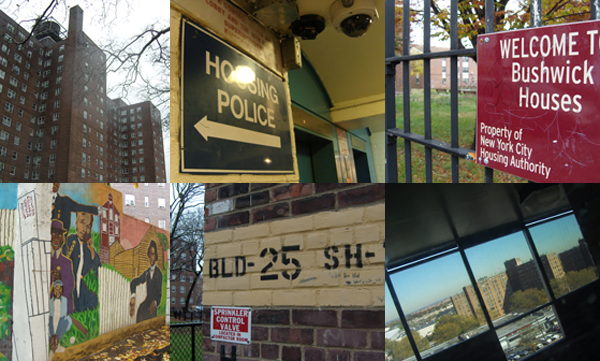
Scenes from NYCHA developments around the city. Clockwise from top left: Red Hook, Wagner, Bushwick, Castle Hill, Ravenswood, Kingsborough.
Among the problems Mayor deBlasio inherited from his predecessor was the abysmal state of the biggest public housing authority in the United States. Shola Olatoye, de Blasio’s appointed chair and CEO, has taken over an authority plagued with problems—from a significant funding shortfall to the rampant progression of mold to an astonishing backlog of work orders. Olatoye replaced the widely criticized John Rhea, whose last chapter as NYCHA chair was marked by controversy of an infill development plan—which proposed creating luxury housing on authority land to close the funding shortfall.
On Saturday, the Community Service Society (City Limits’ former parent organization and a present funder) hosted a forum to discuss some of the ideas in the “Next Generation NYCHA Plan,” an Olatoye -initiated strategy for preserving public housing to be released in May. In attendance were Congresswoman Nydia Velazquez of New York’s 7th district and Gale Brewer, the Manhattan borough president.
While NYCHA leaders were able to convince a room of skeptical resident leaders that it was making progresses on their long list of desperately needed repairs, Olatoye did not win over everyone when it came to demonstrating that the authority has a plan to deal with its deeper problems.
To hear about NYCHA’s plans, about 100 Tennant Association Presidents had come out on the frigid Saturday morning from developments across four of the five boroughs. They came early, some arriving hours before the event was set to begin, and with good reason: the many grievances they wanted addressed.
The pump had gone out at the Wykoff Gardens Development, one leader claimed, and last Sunday, there was no water. The roof of the Warren Street Houses needs to be fixed, another said, not just patched: There is mold in many of the apartments, and raw sewage is leaking into the first floor apartments, too. The Gowanus Development has received a grant for a community center so the residents can have a public space, but despite procuring $4,000 from their councilmember, nothing has been done to create the center. And the elevator in the Reid Houses was broken, so Tenant Association President Aida Thomas had to carry her walker down the stairs. The lobby doors are broken, too. “The conditions in the building are terrible,” Thomas said.
When Olatoye took the podium, she focused on how much progress the administration has made in the 10 months since she took charge, like the reduction of the backlog in work orders by 77 percent, the housing of 1,000 homeless families, the launching of a 501(c)(3) to generate more income for the struggling authority, and the fact that the mayor forgave the $70 million NYCHA was annually forced by the Bloomberg administration to pay the NYPD.
“NYCHA has to operate like any other landlord,” Olatoye said. “You all have the exact same rights as I do in my building.” Olatoye brought NYCHA personnel to take specific work order requests.
The TA presidents seemed to feel mollified. “A lot of my questions were answered,” Thomas, of Reid Houses, said. She feels Olatoye is doing a good job, certainly a much better one than her predecessor. “There’s no comparison,” she said. “He never even came out.”
But there’s a difference between coming out to talk and having a plan. Judith Goldiner, the Attorney in Charge of the Law Reform Unit of the Civil Practice of the Legal Aid Society, spoke on a panel that concluded the event. She acknowledged that the new NYCHA administration does come out and speak to residents, adding that the conversations held as part of Next Generation NYCHA were more genuine than similar sessions in the past. “It wasn’t NYCHA talking at people,” she said later by phone. “Residents had much more of a voice.”
But lingering questions remain, such as how the authority intends to solve its capital shortfall, now at $18 billion by some estimates. It’s unclear whether resident feedback will substantively shape the ultimate NYCHA plan to deal with that deficit, Goldiner added. The direction NYCHA seems to be going is toward more market-rate development along the lines of the infill plan, when residents generally want more affordable housing built.









One thought on “NYCHA Tenants Get a Voice, Wait for a Plan”
Taxpayer-paid gas, electricity and water and they still complain? My combined utilities + NYCRE is about $6900/year. I have no sympathy for these whining leeches.